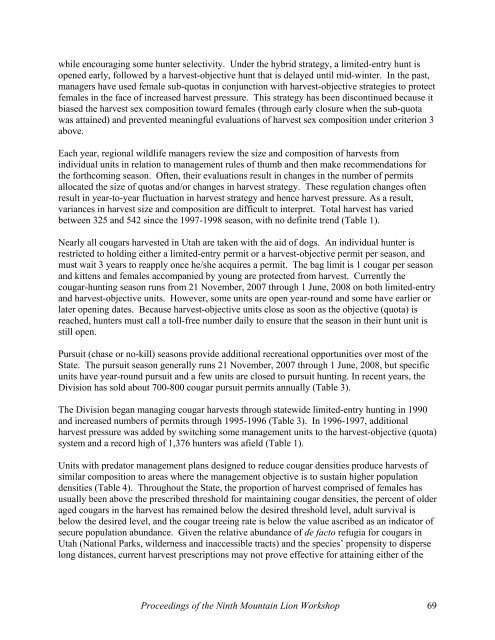Proceedings of the Ninth Mountain Lion Workshop - Carnivore ...
Proceedings of the Ninth Mountain Lion Workshop - Carnivore ...
Proceedings of the Ninth Mountain Lion Workshop - Carnivore ...
You also want an ePaper? Increase the reach of your titles
YUMPU automatically turns print PDFs into web optimized ePapers that Google loves.
while encouraging some hunter selectivity. Under <strong>the</strong> hybrid strategy, a limited-entry hunt is<br />
opened early, followed by a harvest-objective hunt that is delayed until mid-winter. In <strong>the</strong> past,<br />
managers have used female sub-quotas in conjunction with harvest-objective strategies to protect<br />
females in <strong>the</strong> face <strong>of</strong> increased harvest pressure. This strategy has been discontinued because it<br />
biased <strong>the</strong> harvest sex composition toward females (through early closure when <strong>the</strong> sub-quota<br />
was attained) and prevented meaningful evaluations <strong>of</strong> harvest sex composition under criterion 3<br />
above.<br />
Each year, regional wildlife managers review <strong>the</strong> size and composition <strong>of</strong> harvests from<br />
individual units in relation to management rules <strong>of</strong> thumb and <strong>the</strong>n make recommendations for<br />
<strong>the</strong> forthcoming season. Often, <strong>the</strong>ir evaluations result in changes in <strong>the</strong> number <strong>of</strong> permits<br />
allocated <strong>the</strong> size <strong>of</strong> quotas and/or changes in harvest strategy. These regulation changes <strong>of</strong>ten<br />
result in year-to-year fluctuation in harvest strategy and hence harvest pressure. As a result,<br />
variances in harvest size and composition are difficult to interpret. Total harvest has varied<br />
between 325 and 542 since <strong>the</strong> 1997-1998 season, with no definite trend (Table 1).<br />
Nearly all cougars harvested in Utah are taken with <strong>the</strong> aid <strong>of</strong> dogs. An individual hunter is<br />
restricted to holding ei<strong>the</strong>r a limited-entry permit or a harvest-objective permit per season, and<br />
must wait 3 years to reapply once he/she acquires a permit. The bag limit is 1 cougar per season<br />
and kittens and females accompanied by young are protected from harvest. Currently <strong>the</strong><br />
cougar-hunting season runs from 21 November, 2007 through 1 June, 2008 on both limited-entry<br />
and harvest-objective units. However, some units are open year-round and some have earlier or<br />
later opening dates. Because harvest-objective units close as soon as <strong>the</strong> objective (quota) is<br />
reached, hunters must call a toll-free number daily to ensure that <strong>the</strong> season in <strong>the</strong>ir hunt unit is<br />
still open.<br />
Pursuit (chase or no-kill) seasons provide additional recreational opportunities over most <strong>of</strong> <strong>the</strong><br />
State. The pursuit season generally runs 21 November, 2007 through 1 June, 2008, but specific<br />
units have year-round pursuit and a few units are closed to pursuit hunting. In recent years, <strong>the</strong><br />
Division has sold about 700-800 cougar pursuit permits annually (Table 3).<br />
The Division began managing cougar harvests through statewide limited-entry hunting in 1990<br />
and increased numbers <strong>of</strong> permits through 1995-1996 (Table 3). In 1996-1997, additional<br />
harvest pressure was added by switching some management units to <strong>the</strong> harvest-objective (quota)<br />
system and a record high <strong>of</strong> 1,376 hunters was afield (Table 1).<br />
Units with predator management plans designed to reduce cougar densities produce harvests <strong>of</strong><br />
similar composition to areas where <strong>the</strong> management objective is to sustain higher population<br />
densities (Table 4). Throughout <strong>the</strong> State, <strong>the</strong> proportion <strong>of</strong> harvest comprised <strong>of</strong> females has<br />
usually been above <strong>the</strong> prescribed threshold for maintaining cougar densities, <strong>the</strong> percent <strong>of</strong> older<br />
aged cougars in <strong>the</strong> harvest has remained below <strong>the</strong> desired threshold level, adult survival is<br />
below <strong>the</strong> desired level, and <strong>the</strong> cougar treeing rate is below <strong>the</strong> value ascribed as an indicator <strong>of</strong><br />
secure population abundance. Given <strong>the</strong> relative abundance <strong>of</strong> de facto refugia for cougars in<br />
Utah (National Parks, wilderness and inaccessible tracts) and <strong>the</strong> species’ propensity to disperse<br />
long distances, current harvest prescriptions may not prove effective for attaining ei<strong>the</strong>r <strong>of</strong> <strong>the</strong><br />
<strong>Proceedings</strong> <strong>of</strong> <strong>the</strong> <strong>Ninth</strong> <strong>Mountain</strong> <strong>Lion</strong> <strong>Workshop</strong> 69
















